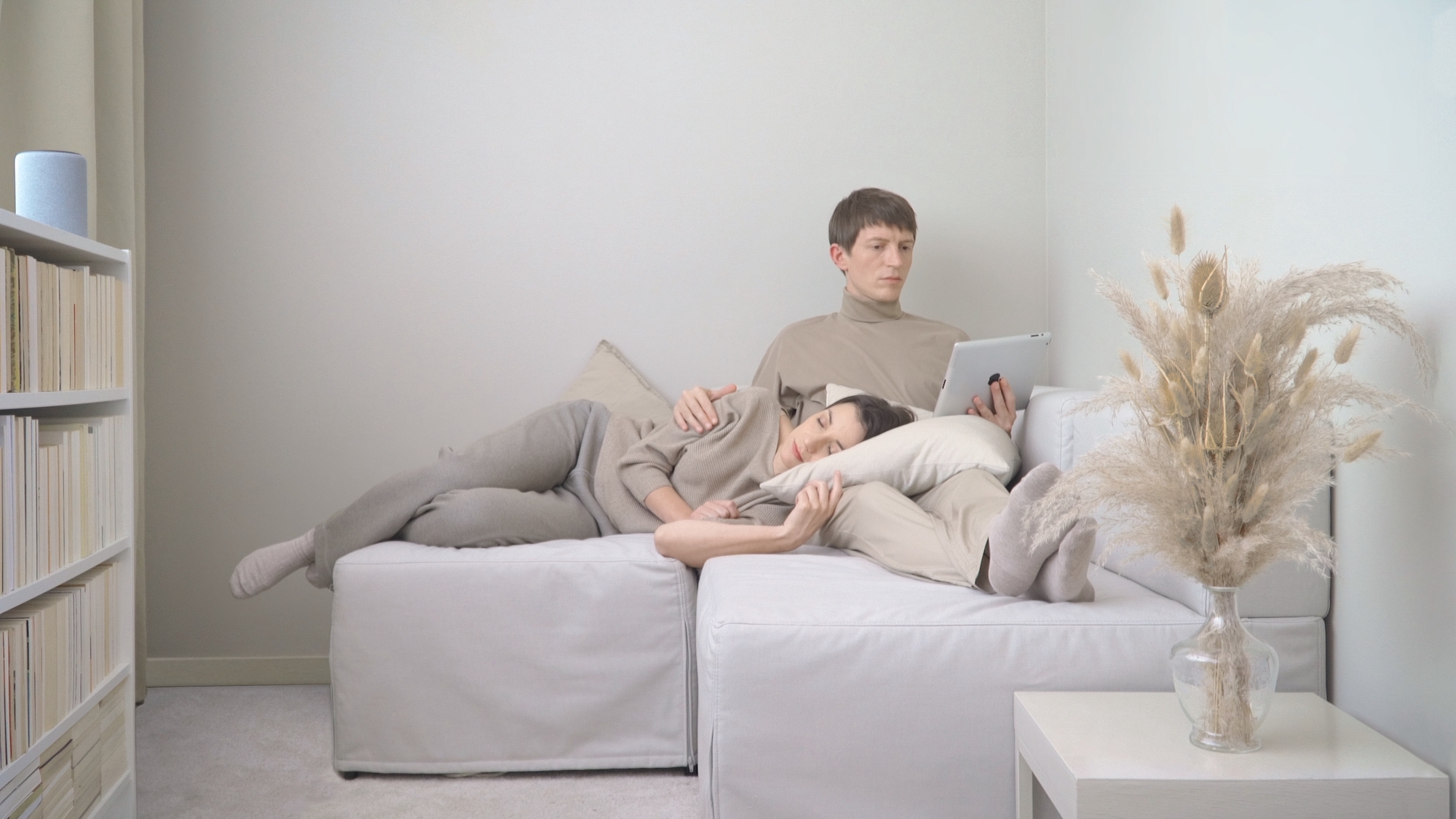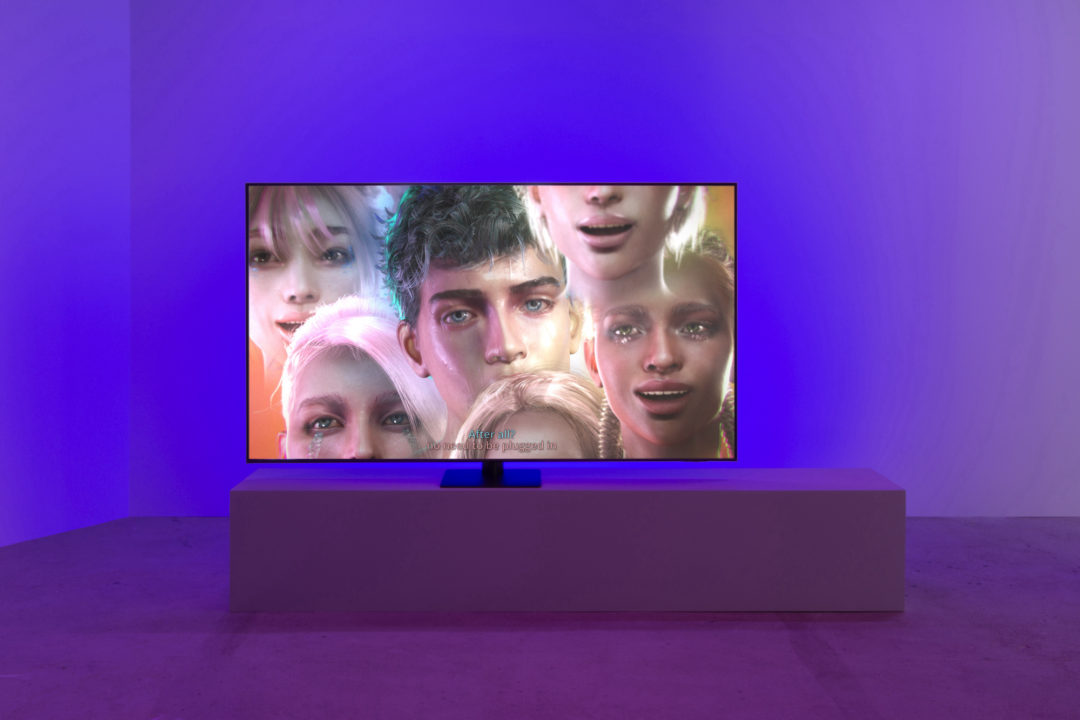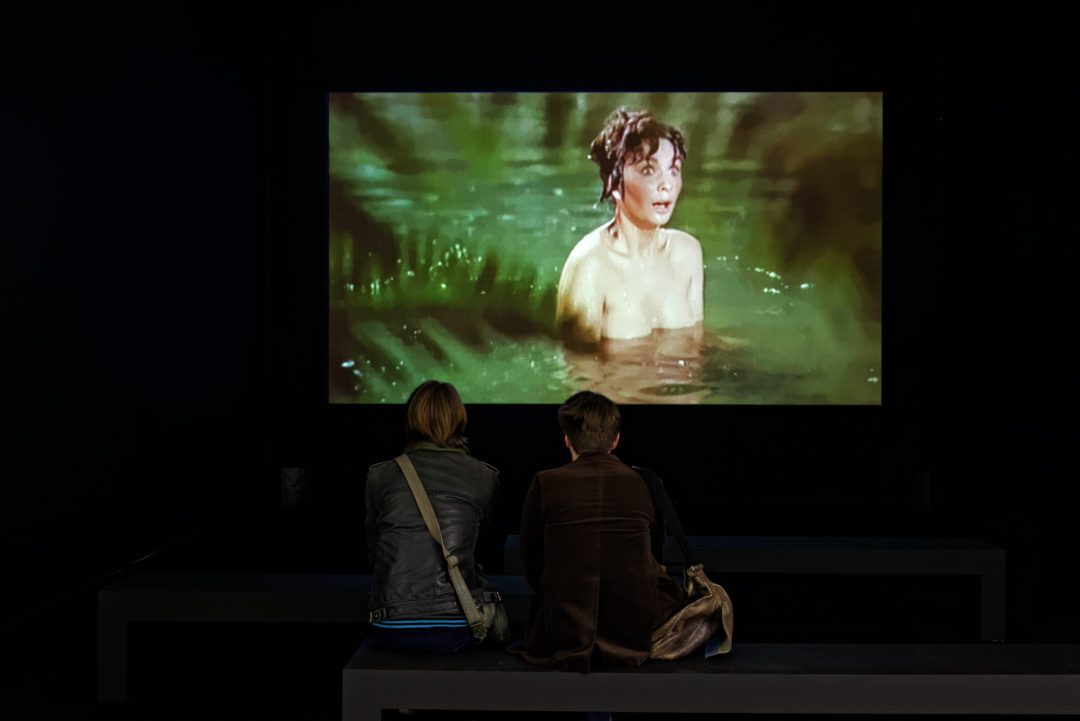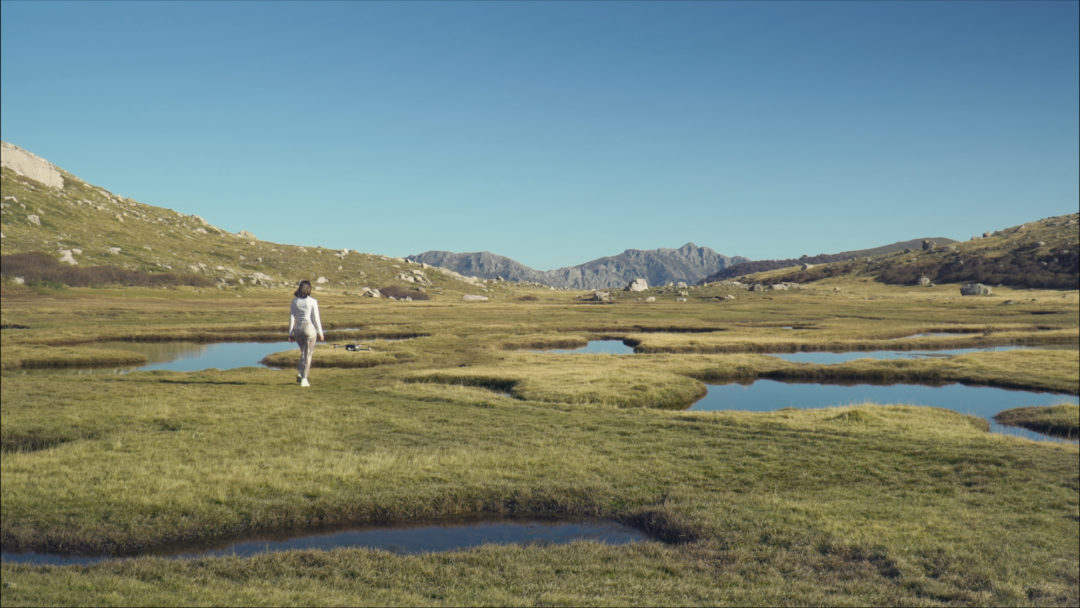Émilie Brout & Maxime Marion

Generated Mode(1)
For some time now, history appears to have been expanding. It moves forward while zooming out, sometimes in slow-motion, oftentimes in patchwork fashion. The appearance of this technical innovation is linked to another, similar occurrence—the epistemological collapse of a given crisis is placed alongside a similar period. For historians, the notion of the “longue durée” was, until recently, considered an illegitimate concept. It is nonetheless a useful tool for anyone wishing to produce different varieties of modernity, while also seeking transtemporal allies. With the development of artificial intelligence, many thinkers are now turning to this alternative form of duration; they share the common goal of a contextualization of our algorithmic era in order to describe the new, progressive sensibilities it has engendered. In other words, it attempts to go beyond the predictable roller-coaster-ride range of emotions: amazement and fright.
A techno-political continuity inherent to writing and recording systems is currently being stitched together; albeit without the magical effect of ex machina inventions. If we were to follow where this thread leads us, we would discover portrayals and narratives which contribute to the processes of art history. For art in particular, artificial intelligence allows a glimpse at a different approach to knowledge, to recorded memory, to the retranscription of knowledge. The generative algorithm does not discriminate among the types of data it receives—from literary sources to user manuals, art history to Fan art. From this point of view, the entire canon of modern art—whose principal function is to excommunicate and to sort—suddenly appears all the more vain; it is revealed to be completely un-adapted to our times and its sentient bodies. During major periods of upheaval, can we expect grandiloquent system resets? Not necessarily.
The work of Émilie Brout and Maxime Marion is a prime example of how an experimental way of thinking and creating can sometimes precede the necessary technological conditions to make it come about, giving rise to a retroactive emergence of feedback loops and new interpretations present in the form of seedlings which, at the time, were experimental multimedia assemblages. In 2023, just as artificial intelligence was making its début in heated, public debates, taking up residence in the columns of journalists of all sorts, the artistic duo had just released its most recent film—IDLE (acts α and β), a musical animated 20-minute long short feature, along with a two-act, behind-the-scenes narration. In a violet-tinged pop universe, two floating angelic heads emerge from a colourful, then cloudy ether. Their overly-toothy mouths open and begin to recite words from a 3.0 opera: an intelligence has been awakened, is trying to appear, just as it discovers the world as-is—uncertain and ambiguous.

Vue de l’exposition / view of the exhibition . IDLE ., 22,48 m., Komunuma, Romainville.
From the Author to AI (And Back Again)
IDLE was partially generated by AI and does not resemble anything familiar; this is because it aggregates everything already familiar. The dizzying effect of association replaces the avant-garde’s shock of the new—because we don’t really know what to do with it and no-one has yet explained how to approach it, aesthetics become a fertile ground ripe for politicisation once again. “By choosing to work with artificial intelligence, we knew we would be removing fingers from heads,” the duo recalled, regarding its protagonists, of which there are seven, and whose vacillating appearance never quite achieves stability. “Technically, there weren’t any other possibilities at the time. Which is precisely why we decided to invest in this tool which eventually guided our writing process, as well.” The choice of a creation story is far from coincidental—all religions feature one, especially the lives of the saints; they were written in a collective mode, and are trans-individual and non-authorial. In more recent times, this method has been referred to as “uncreative writing”
In the case of IDLE, a direct relationship with horizontal creative models originating in Web 2.0 is evident however there is another, more fitting reference. All creative forms may indeed be collective whether we would like them to be or not, with myths and narrative structures providing the undergirding for any individual creative act. In the case of Émilie Brout & Maxime Marion’s film, however, an artistic gesture has been accomplished; an authored work has been produced, in a deliberate way. The artwork remains independent of Web 2.0 paradigms because it is rooted in a different ecosystem—the algorithmic era which many have already established as being completely separate from the post-internet period which directly precedes it. The narrative arc is not merely situated, it is inscribed in a context where a radical, romantic originality has become impossible. “We have borrowed the methods of classical opera by first writing a libretto, followed by a collaborative phase where we work closely with the musicians, then by the frame-by-frame production of the screenplay using a laborious and very artisanal process.” This work is therefore located “within and against” its specific technical and political context.”
Émilie Brout & Maxime Marion approach generative tools with the creative gesture in mind; all the more so because AI evacuates even the minute possibility of romantic subjectivity or modernist authorship. IDLE tells its story twice over—because its narrative emerges from a data set representing material which has already been stored in the form of images and content produced by humans. Everything has already been said and we arrive on the scene only too late; or so it has been said for at least the past seven millennia. And yet, the notion of liberty itself could be based on this very notion—to never again feel obligated to invent original material which no one has thought of before; to be a genius of one’s time. The question is worth pondering: how to find an individual voice when one is creating collectively? The artists ponder the same thing as their characters; they mention that they have them explain that, “An AI can have any sort of face. It receives its data at a given moment, which provides all of the texts, all of the images from magazines and from art history. From this point on, how is it going to evolve? What is it going to become?” This is yet another way of presenting the idea of an original creation that AI seems in essence to contradict—another, or perhaps just another level of differential intensity.
‘Microserfs’, Mega Stereotypes
Émilie Brout & Maxime Marion were born in 1984 and 1982, respectively. They received their art degrees from ENSA Nancy and ESA Aix-en-Provence. They met during a post-graduate program at EnsadLab at the École Nationale des Arts Décoratifs, Paris, which marked the beginning of a collaboration oriented toward open, mobile and process-driven forms of experimentation. This turning point, which came about sometime around the 2010s, allowed them to hone their practices within the context of Web 2.0; blogs, social media and participatory cultures all characterise this period. For many artists in para-institutional milieux, this translates into a search for alternative circuits of diffusion, the use of an expanded bank of iconographic sources and an amateur approach to artmaking. It appears as if there may yet be space for a duo in a history which is as yet unfamiliar in France; an interpretation which leaves space for this type of practice and which would allow the addition of another chapter to this movement.
In the film A Truly Shared Love (2018), the evolution of the artists’ technological multimedia paradigm becomes evident. Here, Émilie Brout & Maxime Marion are the two autofictional protagonists of the story; they appear in the film as do their cat and their apartment. We do not, however, witness their actual lives since the film shows a static, frozen version which holds them prisoners within a series of stereotypes. If we take a step back, a larger imprisonment seems implied; one which takes place in a socio-cultural milieu which is just as mediocre, devoid of asperity and unremarkable. The much-reviled “artistic capitalism” has now triumphed—artists are now considered creatives as opposed to art workers, consenting “microserfs” in a state of utter ataraxia. The film was created using key words linked to images from an online image bank and from stock footage, evoking a flawless aesthetic which breaks down the barriers between private and public space, work and leisure, creativity and communication.
Apple, Roomba and Somneo have become the overseers of the everyday. The former counter-culture is now too close for comfort—biorhythms are monitored in the air-conditioned hellscape of a total neoliberal dream. Each shot has its voice-over which serves as a means of identification, but also creates the potential to purchase each image piecemeal in order to disseminate them in other contexts, on other networks, “This film is a series of tableaux as opposed to shots, with an elliptical structure which is similar to a Powerpoint presentation. Paradoxically, we were initially trying to recreate a sense of continuity.” According to the artists, each new production context is an attempt to confront the blind spots of images, the biases behind image representation. Like IDLE, this film focuses on the disruption of the process of individuation; that inaccessible palette of emotions which remains suppressed until suddenly, the male protagonist in the film frees himself from reproducing clichés and begins singing about darkness, although his voice fails him. Daybreak follows, the loop begins again.

The Pirate and the Siren: Heuristic Alliances for Artists
If, by means of this partial comparison, we were to turn our attention to a para-history made up of recursive loops, the element which allows us to review and close the circle in our current AI era would certainly be Émilie Brout & Maxime Marion’s first feature film, Dérives (Wandering). The artists themselves encourage this link with the project that led them to assemble, between 2011 to 2013, all of the filmed appearances of water since cinema’s inception. “We had already created a database of films depicting water. Next, we wrote a text description of all of the shots from beginning to end, with abstract criteria which would be linked to the element: dispersed, active, a drop, a large expanse…” they explained. “We were playing the role of AI without realising it, because the process was actually comparable to the making of an algorithm. It was a way of evoking archetypes, such as the appearance of a muscular man on a beach or that of a backdrop for a couple kissing.”
At the time it was made, the project was not exactly perceived in this way. For the artists, the appropriation art or found footage aspect may well have been present, however there were also resonances with tropes like fluidity and liquidity which had a foothold during the 2010s; themes which would eventually drift toward an evolutive dimension which itself would later become generative. “The text descriptions also mentioned precise criteria like intensity, dramatic tension, the state of the water element,” they said, with regard to the making of Dérives (Wandering). “What created the illusion of continuity was the feeling as opposed to the narration.” Today, the making of this type of database sounds eerily similar to the early stages of AI, when it was still possible to train models DIY-style. Émilie Brout & Maxime Marion often refer to their Web 1 heritage; the search for alternatives was always subject to the possibility of disconnection. They nonetheless claim to have always had one foot inside, the other out when it comes to institutions and digital art platforms.
With regard to generated content, however, it is as if Web 1 has linked up with Web3. In the 2000s, during the early days of technical experimentation, a group of global justice and media activists created the online platform Indymedia. This distant utopia was a response to separate techno-political forces however the example allows us to look back from where we are currently. The Indymedia slogan, “Don’t hate the media. Become the media!” was a typical call-to-arms advocating a search for alternatives which have since been rendered impossible by global capitalism and the flattening of the algorithm. The fact remains that for the artists who create within and for AI, the call to join forces has a different meaning: it takes on the form of a conscientious search for alternatives, because of the impossibility of extracting oneself from the technical continuum.
The work of Émilie Brout & Maxime Marion—whether technically sound or made in the DIY spirit—makes use of an experimental way of embracing media, using a decidedly new medium. Their method is far from disdainful, and if we consider the duo’s narrative, comes from a place of love; with dormant affection. Their approach is at once realistic and dreamy, haloed by the obstinance of deep sea divers in an expanse of water which has the potential to be loving, menacing or insidious. There, amongst the indistinct eddies of the algorithm, in the middle of an inscrutable immensity, lay scintillating islets. They represent subjectivities in development, the promise of expressivity in the form of germinates. To dive into the water or disappear into the ether; chasing after the lilt of a voice or a spoken song, until it becomes fully operatic. At the end of his life, Kittler who we met in the beginning of this essay, wondered whether “..memorial culture must always emerge from our most murderous histories?” In the work of Émilie Brout & Maxime Marion, the figure of the artist is both a utopian pirate and a siren of the post-capitalist algorithm: one who allows themselves to drown in generic images in order to retrieve a non-human subjectivity and a post-individual form of expression.

1 The title is an indirect reference to the French translation of one of the last lectures of media theorist Friedrich Kittler, “Mode protégé,” (“Protected Mode”)(1993). Two of Kittler’s last conferences on computer programs and the first computers are also compiled under the same title, Mode protégé (2015).
2 The method developed by German historian Reinhart Koselleck (1923-2006).
3 For another perspective, see journalist Kyle Chayka’s Filterworld : How Algorithms Flattened our Culture, 2024, or philosopher Matteo Pasquinelli, The Eye of the Master : A Social History of Artificial Intelligence, 2023. In the first example, Chayka “stretches” his historic perspective to 1769 and the creation of the so-called “Mechanical Turk” invented by Johann Wolfgang Ritter von Kempelen, an Austrian Empire-era civil servant. The second begins with the long history of immemorial mythologies which infringe upon Western dreams of control such as the vedic Agnicuayana ritual, and a more restrictive history of proto-algorithmic techniques with Charles Babbage’s 1823 London invention, the “difference engine”, a mechanical calculator.
4 The German term Aufschreibesysteme is a key concept in Friedrich Kittler’s theories: in a techno-materialistic Foucauldian vein, it designates a network of techniques and institutions which permit the storage and processing of a set of data. See:
5 IDLE. Émilie Brout & Maxime Marion, from Sept 10th-Oct 28th, 2023 at Komunuma, Romainville.
6 The artists began by observing the early stages of AI on the Artbreeder.com site which began in 2018. Starting with GAN models, users are able to generate their own variants by remixing images found on a database of images available to the public.
7 Over the course of this discussion, reference will be made to the three “webs”. Web 1 is characteristic of the beginning of the internet in the 1990s, its utopian pirates, its pseudonymous and collective character, its static status which was meant to be read in a straightforward fashion. Web 2.0 began at the end of the 2000s with the arrival of blogs and social networks, the use of the pronoun “you” and to a lesser extent “I”; real names and the staging of the self, marked by the death of the utopia and the beginning of communication. Web 3 is still contested because it is the most recent version, however it signals the idea of the decentralised web, making use of the blockchain in the financial realm and also of AI in order to achieve a greater infrastructural automatization—contrary to the monopoly of the platforms in former eras.
8 See the oft-cited last lines of the epilogue of The Work of Art in the Age of Mechanical Reproduction by Walter Benjamin (1935-1939). Cinema allowed for politicisation at the time of its inception, as the shock produced on viewers evaded the potential for a distracted attitude in response.
9 All quotes have been excerpted from an interview with the artists which took place in January at their studio.
10 The expression is the French translation of artist and poet Kenneth Goldsmith’s notion of “uncreative writing”, which concerns itself with the circulation of language in the digital era, in a departure from a certain type of non-original expressivity which characterizes our mediated writing. See: Kenneth Goldsmith, Uncreative Writing: Managing Language in the Digital Age (2011)
11 Tiziana Terranova hypothesizes about this in After the Internet: Digital Networks between the Capital and the Common (2022). Terranova defines the “post-internet” period as starting with the birth of the Internet up to the algorithmic era without referring to the usage of the term as it appears within the context of the history of artistic practices.
12 With Gaspar Willman, Esuna, Anne-Marie Agbodji (AI models) ; Music by Anymedge ; Voices by Esuna and Anne-Marie Agbodji
13 Michael Hardt and Antonio Negri argue for this approach in Empire (2000) via a description of a global capitalist imperialism that leaves no stone unturned.
14 In the work of authors such as danah boyd or Henry Jenkins.
15 The term designates more loosely-defined networks which are neither part of Net Art subculture nor the perpetuation of institutional art of previous generations. It is often used when referring to artists from the (contested) post-Internet movement: they find each other on the Internet, via Tumblr or Vimeo, but also exhibit in commercial galleries.
16 Curator and critic Stephen Wright has inventoried a good number of these characteristics in his “lexicon”. See: Stephen Wright, Toward a Lexicon of Usership (2013).
17 The film contains images of works of other artists, which are nevertheless not indicated as such. The scene fragment contains works by Jimmy Beauquesne, Guillaume Constantin, Julie Vayssière, Carin Klonowski et Caroline Delieutraz.
18 We refer here not to Gilles Lipovetsky, who is on the reactionary side of the debate, but rather to a more measured study by Luc Boltanksi et Ève Chiapello, The New Spirit of Capitalism (1999).
19 Douglas Coupland, Microserfs (1995).
20 The film is destined to be screened in the following contexts: within artistic institutions in its full length, and also in the form of short video excerpts to be diffused via Shutterstock or Getty.
21 The paradigmatic example of this notion is Hito Steyerl’s film, Liquidity Inc. (2014)
22 There are a number of works which are based on the system GPT-2, for example in Cooper Jacoby’s series of scripted thermostats. See the artist’s upcoming publication, How Do I Survive ?
23 This anecdote is shared by Félix Tréguer in an extended version. See: Félix Tréguer, L’utopie déchue. Une contre-histoire d’Internet XVe-XXIe siècle, Paris : Fayard, Histoire de la pensée, 2021. p. 204.
24 Friedrich Kittler, “Preparing the Arrival of the Gods” (2008), conference at the Tate Modern in London.
______________________________________________________________________________
Head image : Émilie Brout & Maxime Marion, A Truly Shared Love, 2021. Vid.o 4K / 4K vidéo, 28’. Avec le soutien de la / with the support of the Fondation des Artistes, CNC, Fonds Magn.tic Bordeaux et la
- From the issue: 108
- Share: ,
- By the same author: Hoël Duret, CLEARING, Hanne Lippard, Nicolas Bourriaud, Mark Alizart,
Related articles
Céline Poulin
by Andréanne Béguin
Interview with Warren Neidich
by Yves Citton
La Contemporaine at Nîmes, Anna Labouze & Keimis Henni
by Elora Weil-Engerer

